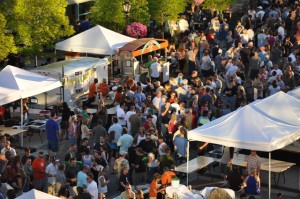DYSTER TELLS IDAHO PAPER LOCAL JEALOUSY HURT HOLIDAY MARKET
By Mike Hudson
While he’s fine telling the people here what a beautiful, up and coming, garden spot Niagara Falls actually is, Mayor Paul Dyster becomes a bit more candid when he’s talking to publications he thinks the folks back home won’t see.
A May 16 article in the Idaho Business Review paints an ugly picture of the city Dyster professes to love even as it defends Idaho resident and Niagara Falls Holiday Market mastermind Mark Rivers.
Dyster told the Podunk publication that Niagara Falls is “quite probably the poorest city in New York State” and seeing Old Falls Street with any people on it was nothing short of a miracle.
Characterizing the city’s downtown as “desolate,” the mayor went on to describe it in colorful fashion.
“There was a pigeon feathers blowing down the empty street type-of-thing,” he said.
The article, by Sean Olson, was meant to defend Holiday Market, last winter’s answer to the Hindenburg disaster, by painting Idaho developer Rivers as the victim of political infighting.
“But supporters in the area say Boise developer Mark Rivers, who grew up in Western New York, is the victim of political crossfire in a town known for parochialism and a distrust of outsiders,” Olson wrote.
The only supporter Olson could manage to dig up was Dyster, who did indeed tell the presumably potato-loving journalist that a lot of the problems surrounding the 37-day event – which became a black hole for $481,000 in taxpayer money – we caused by the City Council here.
“I think there is a lot of ‘not my idea’ jealousy going on here,” Dyster said. “I think the City Council is desperate that some local person does this and they don’t have Rivers pegged as a local.”
 |
 |
|---|---|
| If a picture paints a thousand words, then why didn't the Idaho Business Review, in their defense of Mark Rivers, publish a real photo of his Niagara Holiday Market instead of a summer event that had nothing to do with Mr. Rivers? One look at a photo of the real thing would have undone their thousand word defense of the Market. Meanwhile, no objective voice can figure out where all the public money went? |
|
Dyster, who has made life difficult for numerous developers here even when they never asked for any public funding, shook his head at the close-mindedness of many in the community he purports to lead.
“This is a problem that has existed in Niagara Falls going back decades. People just don’t know how to treat out-of-town developers and business people,” he said.
The conclusion was obvious to journalist Olson, who wrote that Rivers was simply “the victim of political crossfire in a town known for parochialism and a distrust of outsiders.”
Aside from the comedy implicit in the idea that anyone from Idaho would comment on parochialism and a distrust of outsiders existing somewhere else, Olson was simply going where Dyster and Rivers led him.
Rivers, in fact, shed crocodile tears at the tragic unfairness of it all, managing to take a potshot at the city at the same time.
“It’s a lesson learned for me. You can try to do good, but you have to do it in a place where doing good is possible,” Rivers said.
Critics have alleged that Rivers essentially put on a $100,000 event, collected $481,000 from the city and the state, and blew town with what was left over. The festival generated no income for the city, only controversy.
And even Dyster’s condemnation of Niagara Falls as a desperately poor and desolate place where political infighting and a small town mentality preclude progress could not obscure the fact that Rivers’ festival bombed in every single measureable way.
Despite promising 80 vendors and a quarter-million attendees for the 37-day event, the actual numbers speak pretty much for themselves, Olson acknowledged.
“There were 30 vendors, some of whom did not participate in the entire 37-day run. Three concerts booked for the event sold less than 1,000 tickets — including 768 for the Canadian Tenors, 714 for Aaron Neville and 350 for Elisabeth von Trapp. A Santa Claus event drew about 1,400 people,” Olson wrote.
The Neville show allegedly cost $40,000 to stage. Neville was said to have been paid $25,000 for his performance.
Interestingly, around the same time as the Niagara Falls show, Neville played the Mint, a 500-seat nightclub in Los Angeles, where he received a $7,500 fee.
Additionally, only about 370 people actually skated on the ice rink Rivers claimed cost $147,000, bringing in gross receipts of $6,463.
The idea of the city paying promoters to stage concerts and events is unique to Niagara Falls and the administration of Paul Dyster.
Thus far, the City Council has paid only cursory lip service to the notion that such frivolous spending might not be appropriate in a city that can’t afford enough police officers to patrol the streets, tear down abandoned buildings that pose significant public safety and health risks or keep the Department of Public Works offices open eight hours a day during the week.
Dyster used to like to say that his administration would be remembered as one of “big ideas,” but the thought of a poverty stricken backwater using public money to subsidize an already lucrative entertainment industry can only be described as a dumb idea.